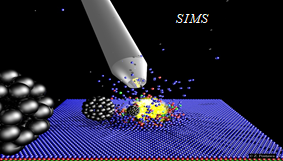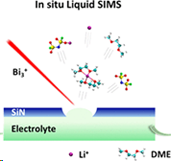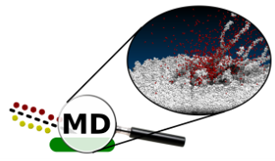Atomic-scale modeling of physicochemical processes accompanying the chemical analysis of materials using new analytical SIMS/SNMS configurations.
Duration: 2020 - 2023

The goal of the project is to investigate phenomena taking place during the bombardment of solid surfaces by energetic projectiles. Rapid progress in miniaturization that has occurred during the last several years led to a significant interest in studies of physical and chemical phenomena that occur in devices with dimensions not much larger than dimensions of individual atoms. This interest resulted in a quest for developing experimental techniques that would be able to measure the geometrical structure and chemical composition in this scale. Secondary Ion Mass Spectrometry (SIMS) and Secondary Neutral Mass Spectrometry (SNMS) are examples of such techniques.

These techniques base on surface bombardment by energetic projectiles, in order to eject into vacuum particles that were initially located at this surface. These particles are subsequently detected in mass spectrometers. The acquired mass spectra are used to determine the chemical composition of the investigated surface. In systems that are equipped in the focused ion beam, it is possible to scan this beam over the surface and gain information about the spatial location of given elements. SIMS and SNMS are currently the only techniques, which allow performing 3-dimensional chemical imaging of materials with sub-micrometer resolution. These techniques are so sensitive that they can find a single atom hidden among billions of other atoms.

Currently, SIMS and SNMS have numerous practical applications. They are used in the process of designing and controlling integrated circuits or OLED diodes, which drive our electronic devices. They also are used to determine the age of the various geological structures, perform forgery check of paintings and sculptures, or help to catch criminals based on the pieces of evidence found at the crime scene. However, the most fascinating application of SIMS/SNMS is its usage in medical research and diagnostics. For instance, these techniques assist in the creation of 3D chemical images of biological cells. They play an essential role in the discoveries of new drugs. Compact and fully automatic SIMS systems are being introduced into the hospital′s operating rooms, where they assist surgical procedures in the fast identification of malignant tumor tissues. Currently, such identification may take days, and, if the diagnosis is inauspicious, the patient must go through surgery again.

The primary objective of the proposed research is to deliver the theoretical background, explanation, and verification of recent findings and hypotheses, which emerge, as SIMS and SNMS expand beyond their current frontiers. State of the art Molecular Dynamics (MD) computer simulations are used to investigate physicochemical processes emerging in new analytical configurations based on new projectiles and liquid supports. Research on liquid supports is particularly essential, as water is the main component of our bodies. It is crucial, therefore, to understand what happens in such an environment. We believe that the proposed studies will assist the SIMS/SNMS community′s current efforts to establish the most optimal experimental conditions to perform 3-dimensional chemical imaging of organic molecules and biological structures. As such, our research will assist in accelerating the further progress of this method.